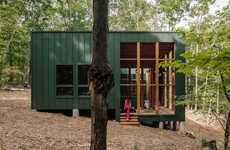The vehicle proving ground located in Khanbogd, Mongolia, sits dormant in the desert until activated by motion. An interactive architecture provides a car testing facility including a flood and freezes hydroplane area, race track, crash zone, break test facilities and 2km of surface road textures for car suspension investigations.
The building is wedged in the Mongolian desert sub-rock that comes to life when in use; all cars are fitted with sensors to activate different testing areas of the building. The building ignites with motion, with glass viewing tunnels running alongside the race tracks. The race track can slide into the desert, separating itself from the main body of the structure, increasing the race track to up to 2km; this reveals a glass atrium and viewing platforms.
Solar panels line the elevated race tracks generating up to 4KW, providing all-year-round access to facilities and frozen grounds.
Dormant Monolithic Architecture
This Space Features a Sensor-Activated Ground
Trend Themes
1. Interactive Architecture - Opportunity for architects and engineers to create responsive and adaptable structures that can enhance user experience and functionality.
2. Smart Sensor Technology - Opportunity to develop sensors to activate and control various functions of a building or facility, providing seamless and efficient user experience.
3. Renewable Energy Integration - Opportunity to integrate renewable energy sources in architectural designs to reduce reliance on electricity grids and promote sustainable development.
Industry Implications
1. Automotive - Opportunity for the automotive industry to test vehicles in a sensor-activated facility that can simulate various driving conditions and terrains.
2. Architecture and Engineering - Opportunity for architects and engineers to design and build interactive and adaptable structures that improve user experience and functionality, utilizing smart sensor technology and renewable energy sources.
3. Renewable Energy - Opportunity for renewable energy companies to provide solar panels and other renewable energy solutions for architectural designs that promote sustainability and reduce reliance on electricity grids.




